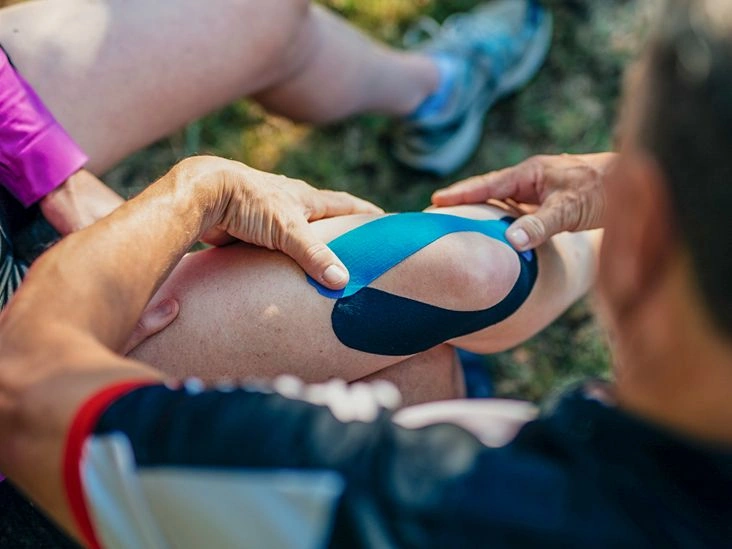Kinesiology tape can offer support, ease pain and swelling, and provide other advantages. Many people apply it to address injuries and boost performance.
Today, there are over 50 brands of kinesiology tape available, but the original—Kinesio tape or Kinesio Tex Tape—was created in the late 1970s by Dr. Kenzo Kase, a Japanese chiropractor who wanted a tape that supported the body without restricting movement the way traditional athletic tapes do.
If you’ve watched a volleyball match or a competitive bike race, you’ve likely noticed it: colorful strips of tape arranged in patterns across shoulders, knees, backs, and abdomens. That’s kinesiology tape: a therapeutic tape applied deliberately to the body to provide support, reduce pain, control swelling, and enhance performance.
Users often report positive results, but so far the research is not definitive about exactly what taping can and cannot accomplish.
Below is a summary of how physical and sports therapists use it, its potential benefits, practical tips, and important considerations.

How does kinesiology tape work?
Kinesiology tape is extremely elastic.
Kase developed Kinesio tape using a proprietary mix of cotton and nylon. It’s engineered to imitate the skin’s elasticity so you maintain your full range of motion. The tape’s medical-grade adhesive is water-resistant and durable enough to remain in place for three to five days, even during workouts or showers.
When the tape is applied, it recoils slightly and gently lifts the skin. It’s thought this creates a microscopic gap between the skin and the tissues underneath.
Creates space in joints
A study with 32 participants found that applying kinesiology tape over the knee increased the joint space.
Another study showed kinesiology tape also enlarged the space in the shoulder joint. While the increase is small, it may help lessen the risk of joint irritation.
May alter pain signaling
Some physical therapists believe the tape modifies the sensory signals your nervous system sends about pain and compression.
Dr. Megann Schooley, a board-certified clinical specialist in sports physical therapy and a certified strength and conditioning specialist, describes it like this:
“All tissues—skin, connective tissue, fascia, muscles—contain sensory receptors that detect pain, temperature, and touch. Those receptors contribute to proprioception—your brain’s awareness of your body’s position and movement. Kinesiology taping creates a lift that unloads the tissues beneath. Decompressing those tissues can alter the signals sent to the brain. When the brain receives a different input, it responds differently,” Schooley explains.
Trigger points illustrate this well. Therapists have applied kinesiology tape over tense, knotted muscles to lift the skin. When the area is decompressed, pain receptors send updated signals to the brain and tension within the trigger point can diminish.
A 2015 study found that combining kinesiology tape with manual pressure reduced trigger point pain and increased flexibility.
May enhance circulation of blood and lymphatic fluid
After an injury, kinesiology tape might help increase circulation and reduce swelling in the affected area.
A 2017 study indicated that kinesiology taping can improve skin blood flow. It may also enhance lymphatic circulation. Lymphatic fluid is mostly water but also includes proteins, bacteria, and other substances. The lymphatic system helps regulate swelling and fluid accumulation.
The idea is that applying kinesiology tape creates additional subcutaneous space, altering the pressure gradient beneath the skin. This pressure change may promote lymphatic flow.
Results across studies vary. In two recent investigations, kinesiology tape reduced fluid accumulation in women after breast cancer treatment and in patients who had total knee replacements.
Altering lymphatic flow could potentially speed bruise resolution. Although research is limited, anecdotally, some people report that when they remove tape from bruised areas, the taped skin appears a different color than nearby untaped skin.
What is kinesiology tape used for?
Treating injuries
Physical therapists sometimes include kinesiology taping as one component of a broader treatment plan for injured patients. The American Physical Therapy Association notes that kinesiology taping is most beneficial when paired with other therapies like manual techniques.
“We use kinesiology taping to reduce pain and swelling,” Schooley says, “but it’s always an adjunct to the primary treatment.”
Supporting weak areas
Kinesiology tape is also applied to give additional support to muscles or joints that are vulnerable. Conditions such as patellofemoral pain syndrome, IT band friction syndrome, or Achilles tendinopathy may respond to kinesiology taping.
Unlike rigid medical or athletic tape, kinesiology tape allows natural movement. Some studies suggest it can enhance mobility and endurance. Research on athletes indicates that applying kinesiology tape to fatigued muscles can improve performance.
Re-educating muscles
Kinesiology taping can help retrain muscles that have lost proper function or adopted maladaptive movement patterns.
For instance, kinesiology tape can be used to correct head and neck posture, and a 2017 study supports its use to help stroke survivors improve gait.
Therapists believe this may occur because the unusual sensation of tape on the skin heightens awareness of posture and movement.
Enhancing performance
Some athletes apply kinesiology tape to optimize performance and reduce injury risk during key events.
“Many runners use this tape every time they run a marathon,” Schooley says. “We sometimes place tape along the glute to ‘wake up’ the muscle and remind it to keep firing.”
Managing scars
Although kinesiology tape should never be placed over open wounds, some evidence suggests it can improve the long-term appearance of scars after surgery or injury. Consult a physician before trying this treatment.
Does it really work?
For some individuals, the answer is yes. However, more research is needed—existing findings are inconsistent. Some trials show no meaningful difference between kinesiology tape and placebo or “sham” taping.
Other studies report small to moderate benefits.
Many reports suggest kinesiology taping is most effective when combined with conventional treatment approaches.
When not to tape
There are situations when kinesiology tape should not be used. These include:
- Open wounds. Applying tape over a wound may cause infection or skin damage.
- Deep vein thrombosis. Increasing fluid flow could dislodge a clot, which can be life-threatening.
- Active cancer. Increasing blood flow to a malignant area could be hazardous.
- Lymph node removal. Encouraging fluid flow where a node is absent may provoke swelling.
- Diabetes. If sensation is reduced, you might not detect an adverse skin reaction.
- Allergy. Sensitive skin can react strongly to adhesives.
- Fragile skin. If your skin tears easily, avoid taping.
How to apply kinesiology tape
Always consult a physical therapist trained in proper kinesiology tape application before trying to tape yourself.
A therapist will demonstrate the pattern that best addresses your issue. Tape can be applied in X, Y, I, or fan patterns depending on the goal. You may also need both stabilization and decompression strips.
Your therapist can observe you practicing application and removal before you do it on your own.
“Taping is not a permanent fix,” Schooley says. “You should build strength and skill because addressing the root cause is essential.”
To apply the tape, follow these steps:
- Clean and dry the area first. Lotions and oils can prevent adhesion.
- Trim excess hair. Fine hair is usually fine, but dense hair can interfere with sticking.
- For most applications, tear the backing paper at the center first.
- Round the corners at the ends of each strip if they aren’t already rounded. Rounded ends are less likely to catch on clothing and help the tape last longer.
- When anchoring the strip, allow the end to recoil slightly after removing the backing. Avoid any stretch in the last two inches at each end—those tabs are only to hold the tape. Stretching the ends can pull the skin, cause irritation, or prompt early detachment.
- Keep fingers on the backing paper to avoid touching the adhesive, which reduces its stickiness.
- Your therapist will advise how much stretch to use. To achieve about 75 percent stretch, extend the tape fully and then release roughly a quarter of its length.
- Use the full length of your thumb across the tape when stretching to ensure an even tension.
- After application, rub the tape vigorously for several seconds. Heat activates the glue. Full adhesion typically takes around 20 minutes.
How to safely remove kinesio tape
If the tape has been worn for several days, it may begin to loosen. Use these tips to remove it without damaging your skin.
- Apply oil (such as baby oil or olive oil) or lotion over the tape to loosen the adhesive.
- Remove the tape slowly. Don’t yank or pull abruptly.
- After lifting one end, press down on your skin to separate it from the tape.
- Pull the tape back against itself rather than straight away. Compress your skin gently while moving the tape back toward the end tab.
- Move your fingers along your skin as you go.
- If your skin becomes irritated or harmed, avoid reapplying tape and consult your therapist or doctor.
Will the tape harm my skin?
Major brands use latex-free, hypoallergenic adhesives, so they generally won’t provoke a reaction if applied correctly and if you don’t have sensitivities. It’s wise to try a small test strip first to be cautious.
How to buy more affordable tape
Prices vary by brand elasticity and durability; a quality roll typically costs $25 to $40.
Schooley recommends purchasing in bulk and sharing with others in a running group or gym. You can also extend wear time by sticking the ends to skin rather than overlapping pieces of tape.
“I always tell patients to tape with intent,” she says. “Yes, it looks cool. But ultimately, the goal is to stop needing the tape.”
Find bulk rolls and pre-cut kinesiology tape online.
The long and short of it
Although evidence around kinesiology taping is limited, it may provide support, boost circulation, reduce pain, and improve joint and muscle function.
Talk with a physical therapist before using it, since it tends to be most helpful when combined with other treatment strategies.


















Leave a Reply
You must be logged in to post a comment.